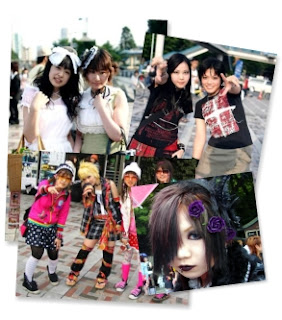Before I start I would like to say I’m so sorry for my semi sporadic sabbatical from posting! There will come a day when I can do this alllll day but unfortunately I get wrapped up sometimes in a thing called WORK… So anyway, let’s talk about fashion on such an outrageous plane that it makes haute couture look ordinary… Let’s talk HARAJUKU!!
A little brief history before we get into all the pretty pics. Looooooooooooooong before Gwen Stefani and her “Harajuku Lovers” there were Harajuku girls. They are popularly known as the 'fashion aficionados' or the 'beauty stars of Japan'(ahem Dames). The term Harajuku refers to the area that they hang around which is the Harajuku train station. It is a style adopted by teens and young adults in the area and its side streets which house tons of boutiques and trendy clothing stores. Japanese Harajuku and Harajuku style has been used to describe teens dressed in many ranging from “Gothic Lolita” (aka Gothic Loli), “Visual Kei”, “Ganguro”,“Kogal” and “cute Kawaii” styled clothing.Like drag queens love their Thursday nights Harajuku’s love their Sunday’s. This is the day they congregate around the station and take part in costume play, dressed up in outlandish costumes to appear like anime characters, punk rock musicians and various gothic styles.
Visual Kei
Visual Kei refers to a movement among Japanase Rock (Jrock) musicians and its fans and is characterized by the use of elaborate costumes, eccentric looks and hairstyles. It involves striking make-up.
The ‘kei' in Visual Kei is Japanese for style of type meaning “visual style music”.
Goth Lolita
Gothic Lolita or GothLoli is a youth fashion among Japanese teenagers and young women. Elegant Gothic Lolita (EGL) refers to the fashion of frilly, ruffled knee-length dresses and head-bands etc. Elegant Gothic Aristocrat (EGA) refers to a more subtle and refined dressing consisting of longer dresses and coats.
Gothic Lolita clothes have a sometimes very dark look or sometimes very kawaii (cute) look - demonstrated by Baby The Stars Shine Bright. There are different kinds of lolitas in Japan, however EGA is rare and the style is usually up to the individual.




Kawaii & Decora
Kawaii means "cute" or "pretty. has become a major aspect of Japanese culture, entertainment, food, clothing, toys, personal appearance and behavior. Kawaii fashion generally relates to someone wearing clothing that appears to be made for young children or clothes that accentuates the cuteness of the individual wearing the clothing. Ruffles and pastel or bright colors may be worn, and accessories often include oversize toys or bags featuring anime characters.
Decora also known as "Decoration" is a Japanese style adopted mainly by young Japanese girls. Decora consists of bright colors and hair clips with bows. Lots of layering and colorful accessories are used in Decora. The accessories include plastic and furry toys and jewelry, which stick together and make noise as the wearer moves.
Ganguro
Gangurofashion appeared somewhere around the early 90s in Japan and peaked around the year 2000 and was primarily adopted by young woman in their 20s. The style consists of a deep tan combined with dyed hair that can be either bleached gray, silver or various shades of orange.
Ganguro girls also wear white lipstick and eye shadow. White concealer is often used for both. Black ink is often used as an eyeliner along with false eyelashes and facial gems (plastic) and pearl powder.
Clothing wise Ganguro girls wear brightly coloured clothes including miniskirts, tie-dyed sarongs, lots or rings, necklaces and bracelets. Ganguro is believed to have started as a kind of revenge against the traditional norm in Japanese society as to what feminine beauty should be. Many Japanese researchers believe that the rebellion against Japanese society is due to resentment of neglect.
Probably the most famous Gangurogirl was known as Buriteri - named after a black soy sauce. Egg magazine made her famous after constantly showing her picture at the height of the Ganguro craze. Ganguro culture even evolved its own style of dances, know as Para Para. Dancers to para para dance to predetermined moves in sync to J-pop music.
Buriteri
Kogal
Kogal girls are know for prominently "showing off" their disposable income through the fashions they wear, their taste in music and their social activity in general. Kogal fashion is similar to that of the sun tanned California Valley Girl.
Kogal fashion is also similar to Ganguro although the two should not be confused. Kogal girls sport designer accessories such as louis vuitton handbags and are often the first consumers of japanese mobile phones. Kogal girls may partake in "compensated dating", which some consider to be quasi-legal prostitution. Internet usage of the word has led some Westerners to believe that "Kogal" means "prostitute".
Although this was a long post I clearly haven’t even scratched the surface of this complex subculture in Tokyo. These girls are Dames because they wear whatever they want and make it look great. I’ve never in a million years looked at someone in a plush teddy bear costume and thought “wow that’s cool or cute” until I saw these pictures. They are fearless, innovative, and fashionable! Although I could see myself being a “Gothic Lolita” with a splash of “Kwaii” (which I could totally do because there are no rules to Harajuku!) I find myself most interested in the Ganguro girls… So, which Harajuku are you?? Stay tuned for the next global Dame post!!! xoxo
Information for this post collected from:
www.harajukustyle.net
http://www.tokyoessentials.com/harajuku.html
http://findarticles.com/p/articles/mi_m0NTN/is_64/ai_n14813550/
www.harajukustyle.net
http://www.tokyoessentials.com/harajuku.html
http://findarticles.com/p/articles/mi_m0NTN/is_64/ai_n14813550/



















No comments:
Post a Comment